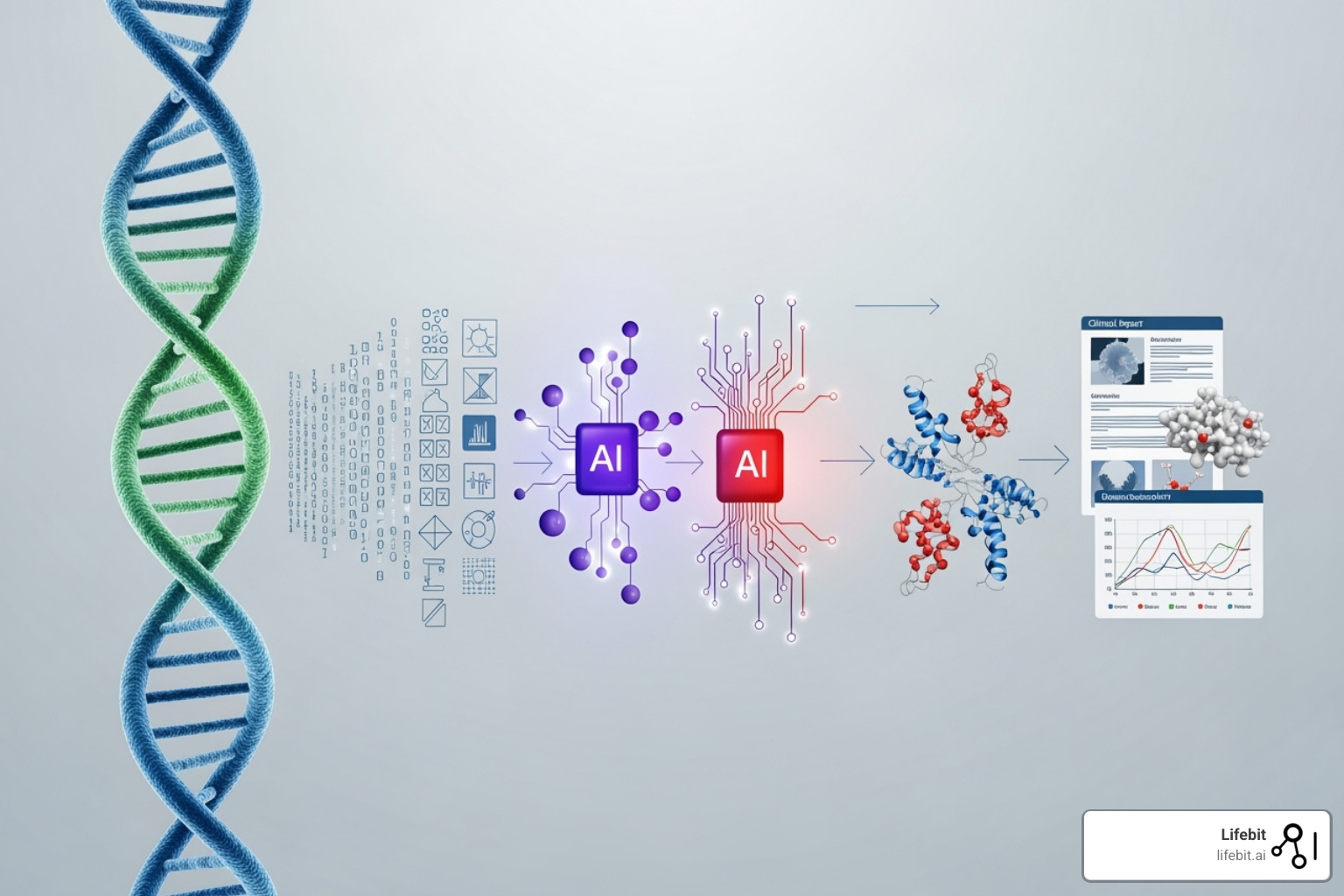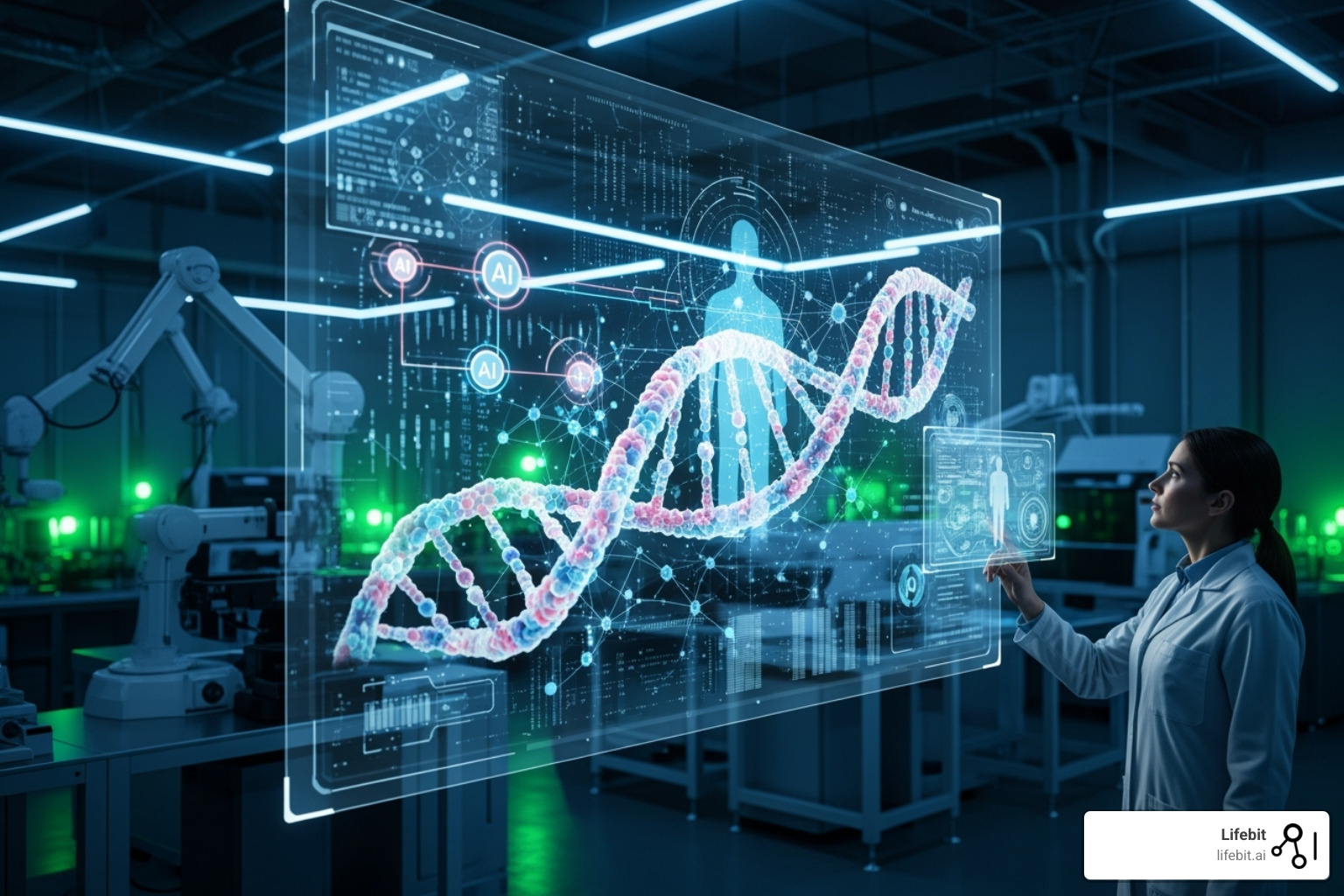Cracking the Code with the Best AI for Genomics

The Data Deluge and the AI Dawn in Genomics
The Best AI for Genomics is changing how researchers open up the secrets hidden within our DNA, turning massive datasets into actionable medical insights. Modern genomic studies generate terabytes of data, a scale that is impossible to manage with traditional methods, especially when considering that less than half of all rice genes are currently understood.
As Dr. Stephen Kingsmore notes: “Accuracy, usability and speed are critical in the application of genetic interpretation.” The challenge isn’t just data volume—it’s making sense of the 98% of our genome that doesn’t code for proteins but controls gene activity.
AI is solving three major genomics problems:
- Variant Analysis: Identifying disease-causing mutations from millions of genetic variants with high accuracy.
- Drug Findy: Finding therapeutic targets in complex RNA biology using powerful foundation models.
- Precision Medicine: Matching treatments to individual genetic profiles through secure, federated analysis.
The Joint Genome Institute reports that AI models can deliver genomic insights in minutes, a task that takes human analysts significantly longer. With genomic data reaching petabyte scales globally, AI is no longer an option but a necessity.
I’m Maria Chatzou Dunford, CEO of Lifebit, where I’ve spent over 15 years developing computational biology solutions. My experience building Nextflow and working at the Centre for Genomic Regulation has shown me how the right AI tools can accelerate precision medicine breakthroughs by helping organizations find the Best AI for Genomics for their research needs.
Key Applications: How AI is Revolutionizing Genomic Research
The integration of artificial intelligence into genomics represents a paradigm shift in biological research, accelerating scientific findy and creating ripple effects across healthcare and agricultural genomics. We’ve moved from manual analysis to AI systems that process terabytes of information in minutes, uncovering insights that were previously impossible to find. The Best AI for Genomics tools are fundamentally changing how we understand life itself.
The impact spans from the lab to the clinic. AI is helping researchers decode our DNA, accelerate drug development, and deliver personalized treatments. For those interested in diving deeper, you can explore more about AI for precision medicine.

Variant Calling and Interpretation
Every person carries millions of genetic variations. Identifying which of these “typos” cause disease from raw sequencing data is like assembling a massive, error-prone jigsaw puzzle. This is where deep neural networks excel.
AI-powered tools can reduce variant calling error rates by over 50%. In one study of over 2,300 cancer patients, AI found disease-causing variants in 14% more individuals than previous methods, enabling more patients to receive targeted treatments.
Beyond identification, AI-driven interpretation explains what these variations mean for health, which is crucial for the 98% of our genome that regulates gene activity. Modern AI systems achieve 98% accuracy in prioritizing clinically relevant variants, dramatically speeding up the journey from testing to actionable insights and providing life-changing answers for families with rare genetic conditions.
Accelerating Drug Findy and Development
Developing new drugs is a decade-long, multi-billion-dollar process with high failure rates. AI is changing this by helping researchers identify therapeutic targets more efficiently and predict molecular interactions, identifying promising drug candidates before expensive lab work begins.
A key breakthrough is the development of foundation models for RNA biology. Unlike single-task AI, these models learn fundamental biological principles and can be applied to multiple drug findy challenges. They can predict RNA expression patterns with incredible detail, opening new avenues for RNA-based therapeutics.
These AI-powered drug findy platforms don’t just accelerate existing processes; they uncover new biological mechanisms. They can design therapeutic candidates, predict their behavior in different tissues, and create surrogate molecules for testing, moving us beyond the limits of traditional methods. For more on this, see our guide to AI drug findy platforms.
Advancing Precision and Personalized Medicine
Imagine a treatment plan designed for your unique genetic makeup. This vision of personalized medicine is becoming reality as AI integrates and analyzes complex biological data.
Patient stratification—grouping patients by their likely response to treatments—is where AI shines. By analyzing genomic, transcriptomic, and other data together, AI identifies patterns that predict treatment efficacy, sparing patients from ineffective therapies.
For rare disease diagnosis, AI rapidly sifts through thousands of genetic variants to pinpoint the cause of symptoms. In cancer genomics, it identifies the specific drivers of a patient’s tumor, enabling precision treatments.
The power of multi-omic data integration is essential for creating a holistic view of health and disease. The goal is not just to treat disease but to prevent it by understanding each person’s unique predispositions. To learn more, explore how organizations are delivering precision medicine at scale.
A Guide to the Best AI for Genomics Platforms and Tools
Choosing the Best AI for Genomics can be overwhelming, with a vast array of models, tools, and platforms available. Assembling the right toolkit is essential to transform the massive scale and complexity of genomic data into meaningful biological insights. The landscape has evolved dramatically; what once took months can now be done in hours with the right AI-powered platform.

Foundational Models: The New Frontier in Genomic Prediction
Just as Large Language Models (LLMs) revolutionized human language, scientists are now applying this approach to decode the “language” of life. Genomic foundation models are learning to read DNA sequences like sentences, understanding context and relationships in unprecedented ways.
For example, leading DNA sequence models can now process up to 1 million DNA letters at once, predicting thousands of molecular properties that characterize gene regulation. This is particularly powerful for understanding non-coding regions—the 98% of our genome that controls gene activity. These models show remarkable performance, often outperforming previous approaches while requiring significantly less computational resources to train.
Here’s what sets these foundation models apart:
| Feature | Traditional ML Models | Genomic Foundation Models |
|---|---|---|
| Capabilities | Task-specific predictions, classification, regression | Multi-modal prediction, understanding complex biological language, broad applicability |
| Data Needs | Often require labeled, curated datasets for specific tasks | Require massive, diverse, often unlabeled datasets for pre-training |
| Applications | Variant calling, disease prediction, biomarker identification | Gene regulation, drug target identification, synthetic biology, understanding non-coding regions |
| Interpretability | Generally more interpretable | Can be less interpretable, but explainability efforts are ongoing |
| Scalability | Scale well for specific tasks | Designed for massive scale and complex data integration |
The real game-changer is their ability to provide comprehensive multimodal prediction in a single framework. Scientists can explore how a genetic variant impacts multiple biological processes with one API call, dramatically speeding up research.
Choosing the Best AI for Genomics: Key Tool Categories
A complete genomic analysis pipeline requires a diverse toolbox. The Best AI for Genomics platforms provide these capabilities directly or integrate seamlessly with existing tools. Key categories include:
- Variant callers using deep neural networks to accurately identify genetic variations.
- Genomic data management platforms for end-to-end data ingestion, storage, and analysis.
- Protein modeling suites to predict protein structures for drug findy.
- Optical Genome Mapping (OGM) analysis tools to interpret structural variations.
- Multiomics solutions that integrate genomics, transcriptomics, and proteomics for a complete biological picture.
Platforms for Scalable Data Management and Analysis
Genomic studies generate terabytes of data, making the integration of AI with High-Performance Computing (HPC) and cloud platforms essential. The most effective platforms use a hybrid approach, combining supercomputers for model training and GPUs for inference to optimize performance and cost.
Data federation addresses the challenge of sensitive, regulated health data. The best platforms enable federated AI, allowing analysis across distributed datasets without moving the data itself. This ensures compliance with privacy standards like GDPR and HIPAA and enables secure global collaboration.
Modern platforms provide a unified architecture for data management, analytics, and AI. This “one architecture for everything” approach eliminates the complexity of connecting disparate systems. Platforms like ours provide scalable and secure analysis in a trusted environment, which is essential for advancing precision medicine.
Overcoming Problems: Preparing Genomic Data for AI Success
Even the Best AI for Genomics tools are only as good as the data they receive. The principle of “garbage in, garbage out” is especially true in genomics, where raw data can be messy and inconsistent. Preparing genomic data is a critical step for achieving accurate predictions and meaningful insights.
Key Steps to ‘AI-Ready’ Genomic Data
Getting genomic data ready for AI is a systematic process. Here are the essential steps:
- Data Cleaning: Perform error correction, remove duplicates, and detect anomalies in raw sequencing data. Always back up original data first.
- Standardization: Ensure consistent data formats, such as converting raw reads to FASTA files, and perform batch effect correction to remove technical variations between sequencing runs.
- Structuring and Annotation: Organize data into a machine-readable format and link genomic features to relevant biological traits and health outcomes.
- Provenance and Version Control: Use systems like Git to track all changes and maintain a clear history of data processing steps.
- Diversity and Balance: Include samples from different populations and balance healthy versus diseased cases to ensure models generalize well.
- Scalability: Plan for data growth from day one with cloud storage, HPC, and automated pipelines.
Navigating Data Silos, Security, and Bias
Genomic data is incredibly sensitive, creating challenges around data privacy, security, and accessibility. Valuable datasets are often locked in institutional silos, yet AI models need large, diverse datasets to be effective.
Furthermore, most genomic datasets have historically focused on people of European ancestry, leading to AI models that perform poorly for underrepresented populations. This is a critical equity issue that impacts healthcare outcomes.
Federated learning is a game-changing solution. Instead of moving sensitive data, it brings AI models to the data, allowing institutions to contribute to model training while keeping their data secure and private.
This requires robust AI governance and adherence to the FAIR principles (Findable, Accessible, Interoperable, Reusable). Our federated approach enables secure, real-time access to global biomedical data with built-in governance, allowing researchers to collaborate while maintaining strict privacy standards. For more details, see this information on federated technology in population genomics.
The Future is Now: Impact and Upcoming Breakthroughs
The Best AI for Genomics is delivering results today while opening doors to future possibilities, from generative biology to comprehensive multi-omics integration. We are moving from simply reading the genetic code to actively writing and predicting new biological functions.
The Tangible Benefits of AI in Genomics Today
The integration of AI into genomics is already providing measurable benefits:
- Faster Diagnostics: AI software can process hundreds of thousands of genetic tests simultaneously, reducing the time to diagnose rare diseases from months to days.
- Improved Crop Yields: AI is helping decode the complex genetics of plants—which have more genes than humans—to develop crops that are more resilient and productive.
- Novel Therapeutics: AI accelerates drug findy by identifying promising targets and designing new drug candidates, dramatically reducing the time and cost of development.
- Reduced Research Costs: AI automates complex bioinformatics workflows and can even generate code, freeing scientists to focus on strategic research instead of routine tasks.
Future Trends: What’s Next for the Best AI for Genomics?
Looking ahead, the possibilities are thrilling. We are on the verge of breakthroughs that will reshape health and disease.
- AI-driven Gene Editing: Imagine CRISPR technology guided by AI to make genetic modifications with near-perfect accuracy, potentially eliminating genetic diseases before they manifest.
- Predictive Health Models: AI will analyze an individual’s genetic blueprint to predict disease risks years in advance, shifting healthcare from reactive to proactive.
- Real-time Pharmacovigilance: AI will monitor drug effects and adverse reactions across populations as they happen, leading to safer medications.
- Decoding Unknown Genes: With vast regions of genomes still unmapped, AI will be our guide to finding new biological functions we never knew existed.
The Joint Genome Institute’s GenomeOcean AI model, which learns the “natural language” of genomes, is a prime example. It can read, write, and predict gene sequences for synthetic biology, replacing years of trial-and-error experiments. This ongoing findy in plant and human genomics continues to accelerate, driving breakthroughs in sustainable biofuels, pharmaceuticals, and more. For additional insights, explore the future of genomics.
Conclusion: Opening up the Genome with Intelligent Tools
The journey through genomics has taken us from a years-long effort to decode the first human genome to analyzing millions of variants in minutes. Today’s Best AI for Genomics tools represent a complete change in how we approach medicine and biological research.
AI is not just helping us read genetic code faster—it’s teaching us to understand the language of life. When foundation models can predict regulatory activity in DNA or open up the mysteries of RNA therapeutics, we are gaining the ability to predict, modify, and even write new biological instructions. This potential is changing healthcare, enabling rapid diagnoses for rare diseases and creating cancer treatments as unique as a fingerprint.
But powerful AI tools are not enough if the data isn’t ready, accessible, and secure. The future of medicine depends on our ability to collaborate across institutions while protecting sensitive health data. Lifebit’s federated platform addresses this challenge head-on, enabling secure data access and advanced AI/ML analytics without compromising privacy. Our approach breaks down the silos that have traditionally slowed scientific progress.
Through our Trusted Research Environment and Real-time Evidence & Analytics Layer, we are building the infrastructure for truly collaborative, AI-driven research. The genome holds the blueprints for life, and AI gives us the tools to read, understand, and improve them. We’re not just cracking the code—we’re learning to write new chapters for the benefit of everyone, everywhere.
Ready to explore how federated AI can transform your genomic research? Learn more about Lifebit’s federated AI platform.


One thought on “Cracking the Code with the Best AI for Genomics”
Comments are closed.